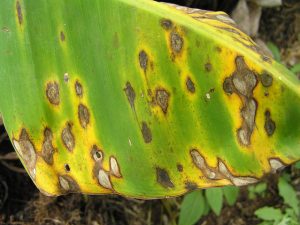Banana is one of the most important fruit crops grown widely in almost all parts of India. India stands 1st in the production of banana worldwide with an estimation of about 33 million metric tons in the year 2021. In India, Andhra Pradesh, Tamil Nadu, Gujarat, Maharashtra and Karnataka are the major banana growing states. However, sigatoka leaf spot is a significant problem for banana farmers in India. Sigatoka leaf spot is a fungal disease that affects banana plants and can cause significant yield loss if not managed properly.
The disease can reduce the yield of banana by up to 50%, resulting in significant economic losses for farmers. It can also impact the quality of the fruit, making it unsuitable for both domestic and export markets. The disease spreads very quickly under favourable conditions and hence its early detection, monitoring and management is crucial to reduce yield loss and protect fruit quality.
Types of Sigatoka Leaf Spot in Banana
Types of Sigatoka leaf spot commonly affecting banana plantation includes;
- Yellow Sigatoka leaf spot (Mycosphaerella musicola)
- Black Sigatoka leaf spot (Mycosphaerella fijiensis)
Among the two species of fungus causing Sigatoka leaf spot in banana, yellow sigatoka leaf spot cause serious threat to the banana production while black sigatoka leaf spot is not much prevalent in India.
Identify the factors causing Sigatoka Leaf spot in Banana
- Environment conditions – High humidity and temperature between 25 – 30°C, rainfall, prolonged leaf wetness as surface moisture helps in quicker spread of disease
- Susceptible varieties – Cultivation of banana varieties that are susceptible to sigatoka leaf spot like Cavendish and Robusta
- Plant nutrition – Plants that are deficient in key nutrients such as potassium are high susceptible
- Field conditions – Poor drainage, presence of infected leaves and plant debris
Symptoms of Sigatoka Leaf spot in Banana

- Initially, light yellow or brownish green streaks appear near the tip or margin of leaf lamina and also on the midrib of the leaves
- Later, these streaks enlarge in size and become spindle shaped spots on foliage with light greyish center surrounded by yellow halo that runs parallel to the veins
- Gradually the leaves dry leading to defoliation of affected leaves
- Under favourable conditions, the disease spreads to entire leaves and becomes severe after the emergence of fruit bunch
- The fruits in the infected plants appear undersized and may ripen prematurely, ultimately reducing the yield.
Preventive Measures
- Grow varieties that are less susceptible to the disease
- Planting should be taken up in well drained soils and maintain proper drainage
- Avoid waterlogging because it can cause the roots to rot and weaken the plant further favouring fungal infection
- Avoid planting suckers with close spacing
- Prune the suckers periodically to avoid overcrowding in the field and maintain only one or two healthy suckers
- Periodically remove and destroy affected leaves to avoid further spreading of fungus
- Do not use pruning tools on infected plants without disinfecting them
- Follow balanced application of fertilizers
- Keep the fields free from weeds and other crop debris
- Irrigation provided under the plant canopy is advised to avoid wetting of leaves and creating high humidity
Management of Sigatoka Leaf Spot in Banana
| Product Name | Technical Content | Dosage |
| Biological Management | ||
| Multiplex Bio-Jodi | Pseudomonas fluorescence & Bacillus subtilis | Foliar: 5 – 10 gm/lit water |
| Anant Dr.Bacto’s Dermus | Trichoderma viride | Foliar: 2.5 gm/lit water |
| T.Stanes Sting Bio Fungicide | Bacillus subtilis | 10 ml/lit water |
| Chemical Management | ||
| SAAF Fungicide | Mancozeb 63% + Carbendazim 12% WP | 1.5 – 2 gm/lit water |
| Indofil M45 Fungicide or | Mancozeb 75% WP | 0.8 – 1.1 gm/lit water |
| Dithane 45 Fungicide | 2 – 2.5 gm/lit water | |
| Blitox Fungicide or | Copper Oxychloride 50 % WP | 1 – 2 gm/lit water |
| Blue Copper Fungicide | ||
| TATA Ishaan Fungicide or | Chlorothalonil 75% WP | 2.5 gm/lit water |
| Jatayu Fungicide | ||
| Cuman L Fungicide | Ziram 27% SC | 1 – 2 ml/lit water |
| Zerox Fungicide | Propiconazole 25% EC | 1 ml/lit water |
| Cabrio Top fungicide | Metiram 55% + Pyraclostrobin 5% WG | 1.2 – 1.4 gm/lit water |
| Taqat Fungicide | Hexaconazole 5% + Captan 70% WP | 2 gm/lit water |
| Katyayani Tebusul Fungicide | Tebuconazole 10% + Sulphur 65% WG | 2.5 gm/lit water |
| Protocol Fungicide | Propineb 70% WP | 5 gm/lit water |
NOTE:
- Use sticking and spreading agent like Anshul Stick Max Adjuvant at 1 ml/lit of spray solution when applying chemical fungicides for effective use efficiency and better management.
- In the case of organic cultivation of banana plantations, use of biological agents mentioned in the table along with Neem oil at 5 ml/lit water which may help in preventing and managing sigatoka leaf spot disease in banana.
- Time of application: Fungicides can be sprayed at an interval of 15 – 20 days.
Conclusion:
Sigatoka leaf spot disease is a fungal disease that poses a significant threat to the banana plants throughout the country. The fungus infects the banana leaves and causes spots, later leading to the drying and defoliation of leaves, affecting the fruit quality and thus reducing the yield. Effective management of Sigatoka disease requires a combination of cultural and chemical control methods, including the use of resistant varieties, effective fungicide applications and maintaining field sanitation. It is crucial to implement these preventive measures and management strategies consistently to protect the banana crop from this devastating disease.
Discover the best practices for planting and packaging bananas.CLICK HERE





